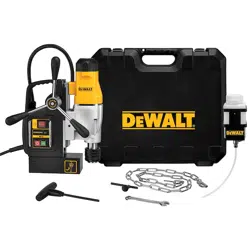Loading ...
Loading ...
Loading ...

ENGLISH
7
Try a few simple projects using scrap material until you
develop a “feel” for themachine.
Switching On and Off (Fig. A, J)
In order to operate properly, the machine has to be
switched following the procedure as described below.
Fig. J
2 3
14
1
Switching the power on and off
Plug the unit into an appropriateoutlet.
To turn the power on, press the power/magnet switch
1
to
the on position (O)
NOTE: Once the power is switched on the magnet will
automatically beactivated.
To turn the power off, press the power/magnet switch to
the off (I) position.
Switching the drill motor on and off
WARNING: Ensure the magnet has secured the drill to
the workpiece prior to turning the motoron.
The drill motor can only be switched on when the magnet
isactivated.
To turn the drill motor on, press the green button
3
on the
motorswitch.
To turn the drill motor off, press the red button
2
on the
motorswitch.
Resetting the machine
If the power is interrupted during use, or if at any point the
magnetic grip is lost, the machine must bereset.
1. Switch off the drill motor first, and then themagnet.
2. Ensure that the work area isclean.
3. Switch on the power/ magnet.
Overload Protection
The
DeWALT
magnetic drill is fitted with an overload
protection feature to prevent damage to the motor if
excessive loads are applied duringoperation.
The LED indicator light
14
will flash as a warning that
excessive load is being applied, if this happens reduce the
pressure being applied until the light is constant green. If
pressure is not reduced the overload will activate cutting
power, at which point the LED will be a solid red. If this
occurs run the unit at no load for several seconds to allow
the motor to cool before resuming the drillingoperation.
Drilling a Hole (Fig. J)
WARNING: Ensure the magnet has secured the drill to
the workpiece prior to turning the motoron.
1. Always apply an appropriate cutting fluid, coolant or
lubricant on the cuttingarea.
2. Make sure the drill point or cutter pilot is properly
installed over the spot to bedrilled.
3. Press green button
3
on the motor switch to the
startmotor.
4. Slowly feed the accessory into the workpiece using the
feedhandle.
5. At the start of the cut, apply light pressure to allow the
accessory to perform the initialgroove.
6. Continue applying sufficient pressure to achieve a
smooth progressive cut. Do notforce.
NOTE: The LED indicator light
14
will flash (red) to
indicate too much pressure is being applied, if this
happens reduce the pressure being applied until the
light changes to a constant (green).
7. The pressure exerted on the handle is too high if the
base comes loose from the worksurface.
8. Take extra care when the accessory is about to break
through the surface to preventsplintering.
9. Always switch off the motor and then the magnet,
in that particular order, when work is finished and
beforeunplugging.
Drilling with Annular Cutters
1. Annular cutters only cut material at the periphery of the
hole, rather than converting the entire hole to shavings.
As a result the energy required to make a hole is lower
than for a twistdrill.
2. When drilling with an annular cutter, it is not necessary
to drill a pilot hole.
CAUTION: Do not touch the cutter or the parts close
to the cutter immediately after operation, as they
may be extremely hot and cause burns to the skin.
Ensure nobody is in the work area where the metal
core isejected.
Drilling Conditions
The ease with which material can be drilled is dependent
on several factors including tensile strength and abrasion
resistance. Hardness and /or strength is the usual criterion,
wide variations in machine ability can exist among material
showing similar physical properties. The drilling conditions
are dependent on requirements for tool life and surface
finish. These conditions are further restricted by the rigidity
of the tool and the workpiece, lubrication and machine
power available. The harder the material the lower the
cutting speed. Some materials of low hardness contain
abrasive substances leading to rapid cutting edge wear
at high speeds. Feed rates are governed by rigidity of set-
up, volume of material to be removed, surface finish and
available machinepower.
MAINTENANCE
WARNING: To reduce the risk of serious personal
injury, turn unit off and disconnect it from
power source before making any adjustments or
removing/installing attachments or accessories.
An accidental start-up can causeinjury.
Loading ...
Loading ...
Loading ...
